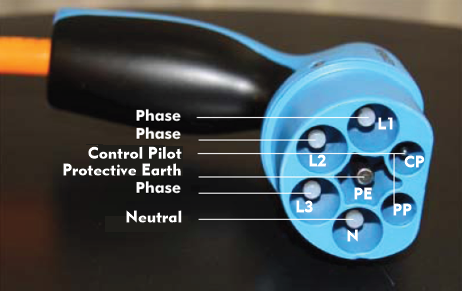control pilot (charge plug) (CP)
There are two signal contacts inthecharging plugs for electric vehicles according to IEC 62196-2; the Control Pilot( CP) and the Proximity Pilot( PP). The signal contacts detect whether an electric vehicle is connected. The charging process is then controlled. Via the CP line, the charging station informs the electric vehicle about the maximum charging current.
A square-wave signal with a frequency of 1 kHz and a voltage of +/-12 V is applied to the CP line. Depending on the battery status, this voltage is dissipated on the vehicle side via a larger or smaller resistor to the protective earth conductor. The pulse width of the square wave signal indicates the current that can be drawn. At a pulse width of 50 %, the maximum charging current is 30 A, at 27 % 16 A and at 16 % pulse width 10 A. If the charging plug is connected to the electric vehicle, then the electric car measures the pulse duration and thereby learns how much charging current is available. As for the resistance value of the leakage resistor, the highest resistance value is 2.7 kilo-ohms, indicating that a vehicle is connected. If charging is required, then this is indicated by a lower resistance value. With a resistance value of 1.5 kilo-ohms, a charging current of 13 A is available, with 680 ohms one of 20 A, with 220 ohms it is 32 A and with 100 ohms 63 A.
As for the proximity contact, it is used to check the actual charging current. Like the pilot signal, this indication is provided by changing resistance values between the contact for the proximity pilot (PP) and the protective earth conductor( PE).

